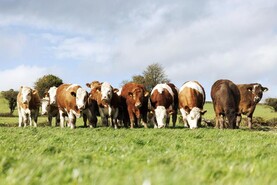Grass: While this week’s bad weather will hamper early grazing plans on many farms, have a plan in place for when the weather and ground conditions improve. Tailor this plan to your farm and try to push the boundaries a little. Nothing ventured, nothing gained. Take a walk around the farm to make sure all fences are in good shape and drinkers are working OK. There is no point rushing to do these jobs when the weather takes up. The aim on dry farms is to have 40% of the grazing area grazed by 10 March and 100% grazed by 1 April. This changes to 20 March and 10 April on wetter farms. The idea here is that grazing the paddocks kick-starts grazing for the spring. If they are not grazed, they won’t start growing as early.
Margins are extremely tight in the beef business, so it’s important to try and reduce costs as much as possible and get animals to grass as quickly as possible. Light weanlings are perfect to start with grazing and if they have to come back in for a few days, it’s not the end of the world. Don’t use the silage pit as the gauge to let cattle out. Getting some fields grazed early will allow for slurry to be spread and also stimulate growth. While ground conditions and soil temperatures are still a little away from spreading, urea should be in the yard at this stage ready to be spread at the rate of a half bag/acre once the weather improves. Once soil temperatures hit 5-6°C, fertiliser can go out.
Calving records: While more and more farmers are using apps on their phones to register calves, many farmers still use the ICBF pocket notebook to record calving data. No matter what system is used, recording some details can be very useful when it comes to culling consistent poor performers, udder problems, calving problems, docility issues etc. These issues can often be forgotten about once a cow and calf are turned out. Some farmers will use a coloured tag on these animals for ease of identification later on in the year. With cull cows still a steady trade in marts, don’t be tempted to keep any free loaders if they are not performing.
Dairy Calf-to-Beef Webinar: Next Wednesday night (24 February) sees the second instalment in our series of spring livestock webinars. The next topic we will cover is dairy calf-to-beef production. There is huge interest in the system and it is important that people go down that road with their eyes wide open and look at some of its advantages and disadvantages. On the night, Aidan Brennan and I will take a look at some of the industry challenges in relation to dairy beef production. Declan Marren will outline some of the performance and economic results from the THRIVE programme and go through some handy tips on calf rearing. Joe Burke, Bord Bia will join in on a panel discussion at the end of the night. If anybody has questions they want answered on the night, they can email them to webinar@farmersjournal.ie or contact 086-836 6465. Questions can also be submitted live on the night via email and WhatsApp.






 This is a subscriber-only article
This is a subscriber-only article










SHARING OPTIONS: